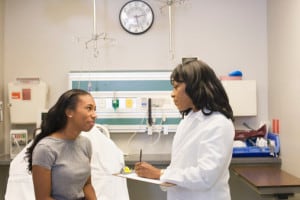At a time when disparities in breast cancer survival are rising dramatically among black women, a new study questions the value of mammography, while other new research reports on more powerful treatments. Olufunmilayo Olopade, M.D., F.A.C.P., director of the Center for Clinical Cancer Genetics at the University of Chicago, an expert on breast cancer risk assessment and breast cancer in black women, weighs in on how we should approach prevention now.
~~~
Fierce: Women everywhere got quite a shock in February when a team of Canadian researchers reported that mammography may not lower death rates from breast cancer. The American Congress of Obstetricians and Gynecologists, American Cancer Society, and American College of Radiology swiftly made a statement disagreeing with the study and sticking with the recommendation that women start getting annual mammograms at age 40. The Canadian study also failed to include significant numbers of black women. What do you think of the new mammography debate?
Olopade: My take on this is that when it comes to breast cancer, we have actually
been moving forward, not backward. This Canadian study is not the last word on mammography, but women should see mammography as only one part of a breast cancer screening and prevention plan. This new research highlights the need for women to take a more personal approach to screening.
Fierce: What can we learn from the latest research?
Olopade: The Canadian study looks at mortality. But if you are a black woman and your mortality risk is coming from triple-negative breast cancer, you may not have had a first mammogram yet. [TNBC is an aggressive form of the disease most often diagnosed in younger women.] TNBC is less likely to be found during a mammogram. So the more important message I want to give to black women is that you should learn to assess and manage your risk.
I also want women to know that thanks to new research, we have new and far more effective forms of treatment [including neodjuvant therapy, a pre-surgical treatment that is highly effective against TNBC, and advances in treating other types of breast cancer].
Breakthroughs in personalized medicine [tests or treatments tailored to your genetic profile] have also improved our ability to determine who might get breast cancer or respond well to certain treatments.
Fierce: What is the most effective way for a black woman to use breast cancer screening to protect herself?
Olopade: Realize that you have to do more than get a mammogram to protect yourself. Keep up with mammography screening starting at age 40, but you must also do a personal risk assessment. Depending on your family history, you may need a mammogram and an ultrasound.
Breast self-exam is less popular than it once was because it can lead to false positives, but it is very important for you to know your breasts and pay attention to any changes. Self-exams can help you keep track of what is normal for you. All women should learn about the symptoms of breast cancer that only you may recognize at first. [These include: a lump, dimpling, redness or scaling skin, changes in size or shape].
If your mammogram, self-exam or other tests turn up something, be sure to follow up. Do not find a lump and ignore it. Get to a specialist. Do not delay treatment.
Fierce: Is there a way for each woman to calculate her personal risk?
Olopade: Yes, the National Cancer Institute’s online breast cancer risk assessment tool is an excellent start. It includes questions that measure risk in African-American women. But once you use the tool and get your assessment, talk it over with your doctor so that she or he can work with you to develop a personalized approach to screening. If you have a very strong family history, you may want to consider genetic testing to see if you have altered BRCA1 or BRCA2 genes. Women with these mutations are at an increased risk of developing the disease.
Fierce: Why the new approach. Why isn’t a mammogram enough?
Olopade: Because research has taught us that breast cancer risk is very different for each woman. The best way to safeguard your health is to take your risk into your own hands. Keep a careful watch on your body. And again, do not be afraid to seek treatment. We’ve made significant progress. The good news is that we have better treatments now than ever before.










